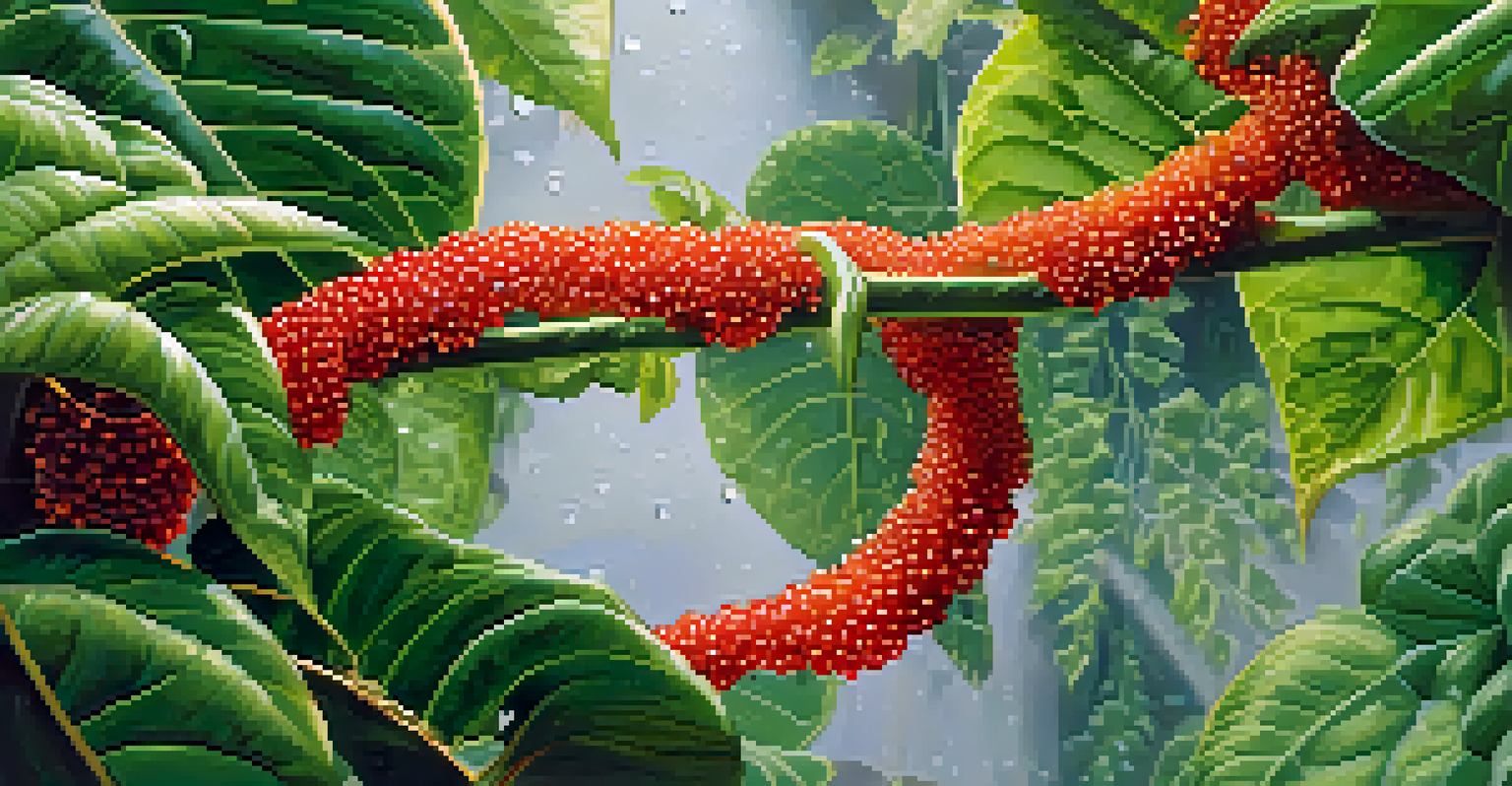The Science Behind Ayahuasca and Therapeutic Bonds

What is Ayahuasca and Its Historical Context?
Ayahuasca is a traditional Amazonian brew made from the Banisteriopsis caapi vine and other plants, known for its psychoactive properties. Used for centuries by Indigenous cultures, it serves both spiritual and healing purposes. The brew is often consumed in ceremonial settings, where it is believed to promote emotional and physical healing.
The experience of ayahuasca can lead to profound insights and revelations about one’s life, relationships, and mental health.
Historically, ayahuasca has been integral to healing practices, rituals, and community bonding in various Amazonian tribes. The experience is often guided by a shaman, who facilitates the journey and ensures safety. This deep-rooted cultural significance lays the groundwork for its contemporary therapeutic applications.
In recent years, ayahuasca has gained popularity outside of its traditional settings, attracting individuals seeking alternative healing methods. This growing interest has sparked scientific research into its effects, particularly how it can create therapeutic bonds between participants and facilitators.
The Chemical Composition of Ayahuasca
The magic of ayahuasca lies in its unique chemical composition, primarily the presence of DMT (dimethyltryptamine) and MAOIs (monoamine oxidase inhibitors). DMT is a powerful psychedelic that induces intense visual and emotional experiences, while MAOIs prolong DMT's effects by preventing its breakdown in the body. This combination leads to profound introspective journeys that many users describe as transformative.

When consumed, ayahuasca can lead to experiences of deep connection, self-discovery, and emotional release. Users often report insights into their past traumas, relationships, and personal struggles. This process can foster a sense of healing and understanding that is difficult to achieve through conventional therapy alone.
Ayahuasca's Healing Tradition
Ayahuasca has been used for centuries by Indigenous cultures for spiritual and healing purposes, fostering deep emotional and physical healing.
Moreover, the effects of ayahuasca can vary greatly from person to person, influenced by factors such as dosage, mindset, and environment. This variability adds to the brew's mystique and appeal, as individuals navigate their unique paths toward healing and self-awareness.
Neuroscience Behind Ayahuasca Experiences
Recent studies have begun to explore the neuroscience of ayahuasca, revealing how it impacts the brain during its use. Research indicates that ayahuasca can enhance neuroplasticity, which is the brain's ability to form new connections and adapt. This characteristic is crucial for recovery from trauma and mental health disorders, as it allows individuals to rewire their thought patterns.
Engaging with ayahuasca responsibly means acknowledging its cultural significance and the people who have preserved its traditions.
Additionally, ayahuasca has been shown to increase connectivity between different brain regions, promoting a more integrated sense of self. This can lead to profound insights and revelations about one’s life, relationships, and mental health. Such experiences can create a therapeutic bond between the individual and their facilitator, fostering a supportive environment for healing.
Furthermore, the emotional release often associated with ayahuasca can help individuals confront and process suppressed feelings. This cathartic experience can be pivotal in establishing trust and rapport, essential components in any therapeutic relationship.
Creating Therapeutic Bonds Through Shared Experiences
One of the most significant aspects of ayahuasca ceremonies is the sense of community they foster. Participants often share their experiences and emotions, creating a bond that can be incredibly healing. These shared journeys can help individuals feel less isolated in their struggles, reinforcing the idea that they are not alone in their healing process.
The presence of a skilled facilitator also plays a crucial role in establishing therapeutic bonds. A facilitator guides participants through their experiences, offering support and encouragement. This relationship can enhance feelings of safety and trust, allowing individuals to delve deeper into their emotions and experiences during the ceremony.
Neuroscience and Mental Health
Research indicates that ayahuasca enhances neuroplasticity and brain connectivity, facilitating transformative insights and emotional processing.
Moreover, the vulnerability that arises during these sessions can lead to lasting connections among participants. Many find that these bonds extend beyond the ceremony, creating a supportive network that encourages ongoing healing and personal growth.
Therapeutic Applications of Ayahuasca
Ayahuasca has been investigated for its potential benefits in treating various mental health issues, including depression, anxiety, and PTSD. The brew's ability to facilitate deep introspection and emotional processing can be particularly beneficial for individuals grappling with these challenges. Many users report significant improvements in their mental health following ayahuasca ceremonies.
Clinical studies have shown promising results, indicating that ayahuasca may help alleviate symptoms of depression and anxiety. By promoting emotional release and fostering new perspectives, the experience can lead to lasting changes in mindset and behavior. This therapeutic potential is attracting attention from mental health professionals seeking alternative treatment options.
Furthermore, as research continues to unfold, the integration of ayahuasca into therapeutic practices is becoming more mainstream. Some therapists are incorporating elements of the ayahuasca experience into their work, aiming to provide a holistic approach to healing that combines traditional and modern methodologies.
Cultural Sensitivity and Ethical Considerations
As ayahuasca gains popularity in Western contexts, it raises important questions about cultural sensitivity and ethical practices. Many Indigenous communities view the brew as sacred, integral to their cultural identity and healing practices. Therefore, it is essential for those seeking ayahuasca experiences to approach it with respect and understanding of its origins.
Moreover, ethical concerns arise regarding the commercialization of ayahuasca retreats and ceremonies. Some profit-driven organizations may prioritize financial gain over the well-being of participants, leading to potentially harmful experiences. Ensuring that facilitators are properly trained and that ceremonies are conducted with care is crucial to maintaining the integrity of this ancient practice.
Ethical Use and Cultural Respect
As ayahuasca gains popularity, it is crucial to approach its use with cultural sensitivity and ethical considerations to honor its Indigenous roots.
Engaging with ayahuasca responsibly means acknowledging its cultural significance and the people who have preserved its traditions. By doing so, participants can honor the roots of ayahuasca, fostering a more respectful and meaningful connection to the plant medicine.
Future Directions in Ayahuasca Research and Therapy
The future of ayahuasca research looks promising as more studies are conducted to explore its therapeutic potential. As the scientific community gains a deeper understanding of how ayahuasca affects the brain and mental health, more evidence-based practices may emerge. This could pave the way for integrating ayahuasca into conventional therapeutic settings.
Additionally, ongoing research will likely focus on optimizing the ayahuasca experience to enhance its benefits while minimizing risks. This could involve studying different plant combinations, dosages, and settings to determine what works best for various psychological conditions. The goal is to tailor the experiences to individual needs, making therapy more effective.

Finally, as awareness of ayahuasca continues to grow, there will be an increasing emphasis on ethical practices and cultural respect. Future research will likely address these considerations, promoting a framework that honors the traditions of Indigenous cultures while exploring the healing potential of this powerful brew.